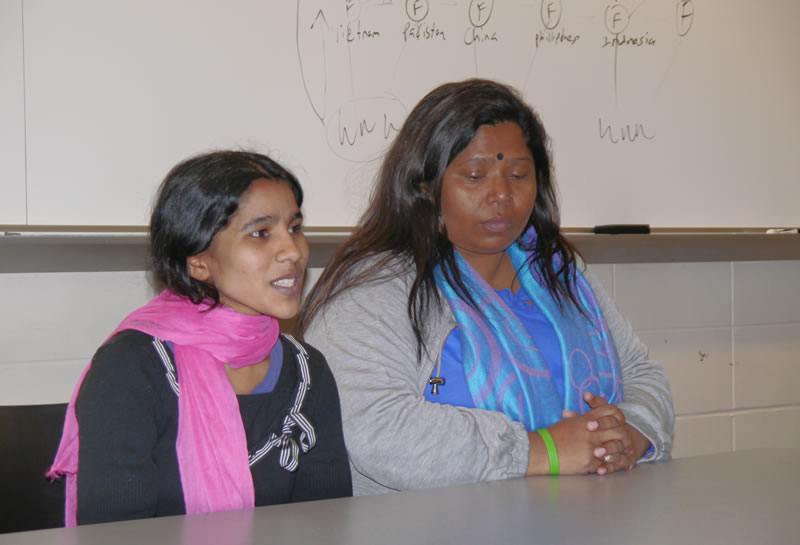

Share
Reba Sikder remembers waking amidst the rubble of her collapsed factory to the moans of a co-worker, trapped where the ceiling had fallen on him. With her leg pinned by debris, she was unable to help him.
“After a few minutes, he died,” she said, tears welling up in her eyes. “I started losing hope that I would survive.”
Sikder was one of some 3,600 workers employed at the Rana Plaza factory in a sub-district of Dhaka, the capital of Bangladesh, when their building collapsed on April 24. At least 1,135 were killed and hundreds injured. She told her story Friday to a crowd of 50 University of Minnesota students in a program sponsored by the United Students Against Sweatshops.
Trapped in the collapsed building for hours, Sikder finally freed herself from the debris. Then she and other survivors struggled to find their way out through air that was dark and thick with dust. At each turn, it seemed, their exit was blocked by rubble.
“I saw many of my co-workers, trapped like a sandwich, one upon the other,” Sikder said. “It’s true that I survived, but I left many of my co-workers behind. I saw many of my co-workers die.”
Finally, the group found a hole through which to escape. On the other side, rescuers were digging desperately through the rubble, pulling out bodies. Many of those who survived had to have limbs amputated.
A terrible pattern
Bangladeshi politicians decried the disaster and the owners were jailed. But the collapse fit an all-too-familiar pattern in the factories, which produce clothing for major brand names like Nike, JanSport and Gildan Activewear, which are licensed to produce college-logo merchandise for U.S. universities.
“Reba’s story is one of many,” said Kalpona Akter, leader of the Bangladesh Center for Worker Solidarity, who is accompanying Sikder on a tour of 11 college campuses.
In the last eight years alone, more than 1,800 Bangladeshi garment workers have died in building collapses and factory fires, according to the Center.
What’s particularly tragic about Rana Plaza is the fact that, the day before the collapse, workers identified cracks in the building and evacuated. The next day, they were told the structure had been inspected and was safe. Those who questioned that decision were threatened with firing.
“One of our production managers was slapping and telling the female workers to go inside,” Sikder recalled. Less than an hour after they entered the building, the nine-story structure collapsed.
The majority of Bangladesh’s 4 million garment workers are young women, whose income is crucial to supporting their families. Sikder began working in the factories at age 14, with her first job paying $23 a month.
At Rana Plaza, she was earning $90 a month by working from 8 a.m. to 10 p.m., seven days a week.
Akter worked in the factories from the age of 12 until she was blacklisted for speaking out about safety conditions and other issues. She now works for an organization that supports union organizing and other collective action.
“There is no doubt we need these (garment industry) jobs,” Akter said. “But we want these to be jobs with dignity.”
Connecting with U.S. campuses
That’s where students at the University of Minnesota and other U.S. campuses come in, by calling on their institutions to put pressure on the companies that produce the college-logo clothing, Akter said.
Specifically, she said, the manufacturers need to sign the Accord on Fire and Building Safety, a legally-binding agreement designed to make all garment factories in Bangladesh safe workplaces. It includes independent safety inspections at factories and public reporting of the results of these inspections.
Where safety issues are identified, retailers commit to ensuring that repairs are carried out, that sufficient funds are made available to do so, and that workers at these factories continue to be paid a salary.
The Accord holds the major brands responsible for the conditions at the factories that produce their clothing, even though they don’t own the factories.
The Bangladesh workers also are seeking compensation for the Rana Plaza collapse and other factory disasters. Nearly a year later, almost 200 workers are still missing.
Akter and Sikder met with a representative of the University of Minnesota to discuss licensing and got a sympathetic response but no commitment, Akter said. “We need your support,” she told the students.
Recently, Duke University, the University of Pennsylvania, Temple University, and New York University announced they would require brands that manufacture their university apparel to sign the Accord. So far, the combined force of student pressure and worker mobilization in the streets of Dhaka has compelled Adidas, Top of the World, Fruit of the Loom, Knights Apparel, and Zephyr Headwear to sign the Accord.
Learn more about the “End Deathtraps” campaign at the United Students Against Sweatshops website.

